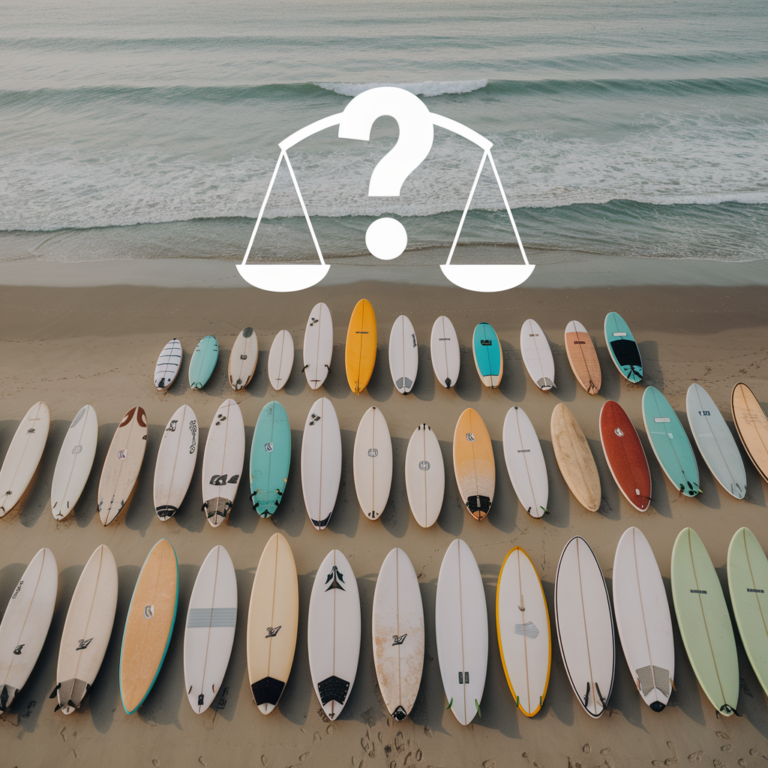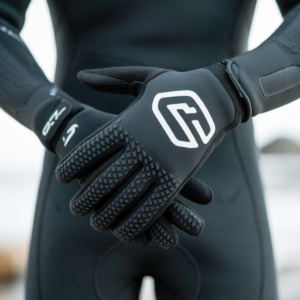Whether you’re a seasoned surfer or a newbie catching your first wave, understanding the weight of different surfboard types can help you make an informed decision. In this article, we’ll explore 25 examples of surfboard weights, giving you a comprehensive guide to find the board that suits your style and needs. Let’s dive in and discover the variety of weights that surfboards come in!
The Weight Spectrum of Surfboards
When navigating the diverse world of surfboards, the weight of each board is a critical factor influencing its performance, buoyancy, and overall feel in the water. Surfboard weight can range significantly, affecting everything from speed and agility to stability and ease of paddling. Let’s delve into the myriad aspects of surfboard weight, exploring how it impacts your surfing experience.
Understanding Surfboard Weight Categories
Surfboards generally fall into several weight categories, each designed to suit different surfing conditions and styles. Here’s a breakdown:
- Lightweight Boards (4-6 lbs.): These boards are typically shortboards favored by advanced surfers for their agility and responsiveness. They excel in performance surfing, allowing for quick maneuvers and sharp turns.
- Midweight Boards (6-10 lbs.): This category includes most hybrid and funboards, balancing performance and stability. They are versatile, making them ideal for various wave conditions and surfer skill levels.
- Heavyweight Boards (10-15 lbs.): Known for their durability and stability, these boards are preferred in larger, rougher surf. They provide excellent paddling power and are less affected by strong currents, making them a staple for big wave surfing.
Factors Influencing Surfboard Weight
- Material Composition: Traditional surfboards are often made from polyurethane foam with fiberglass cloth, adding weight. Modern constructions, such as epoxy boards, incorporate lighter materials like EPS foam and carbon fiber, significantly reducing weight.
- Board Length and Volume: Generally, longer and thicker boards tend to be heavier. However, the volume of the board also plays a crucial role in its buoyancy and weight distribution.
- Design and Shape: The design elements, such as the rocker (curve of the board), tail shape, and rail thickness, can also impact the board’s weight. For instance, a board with a flatter rocker and fuller rails tends to be heavier but more stable.
Performance Implications of Surfboard Weight
The weight of your surfboard directly affects its performance in various conditions:
- Paddling and Catching Waves: Heavier boards generally offer better paddling power and stability, making them easier to catch waves with. Lightweight boards, while faster, require more effort to paddle into waves.
- Maneuverability and Control: Lighter boards are renowned for their maneuverability, allowing surfers to execute rapid turns and tricks. Heavier boards, though less nimble, provide superior control in larger, more challenging surf.
- Stability and Ride: Stability is a critical factor, especially for beginners. Heavier boards offer greater stability, reducing the likelihood of falling off. Advanced surfers often opt for lighter boards to enhance their agility and performance.
25 Examples of Surfboard Weights: A Comprehensive Guide
Now that we’ve covered the importance of surfboard weight and its impact on performance, let’s dive into specific examples. Below is a table showcasing 25 different surfboards, their respective weights, and some key characteristics.
| Surfboard Model | Type | Weight (lbs.) | Length (ft) | Key Characteristics |
| Firewire Sci-Fi 2.0 | Shortboard | 6 | 5’8″ | Lightweight, high-performance, rapid turns |
| Lost V3 Rocket | Hybrid | 7 | 5’10” | Versatile, user-friendly, good for various conditions |
| Channel Islands Biscuit | Funboard | 8 | 5’10” | Stable, easy paddling, great for small waves |
| Catch Surf Odysea Log | Soft Top | 12 | 7’0″ | Durable, buoyant, ideal for beginners |
| Pyzel Ghost | Shortboard | 6 | 6’0″ | Agile, suitable for powerful waves |
| Bic Sport G-Board EVO | Soft Top | 13 | 8’0″ | Highly durable, perfect for surf schools |
| Haydenshapes Hypto Krypto | Hybrid | 7.5 | 5’10” | Balanced performance, suitable for all levels |
| JS Industries Monsta Box | Shortboard | 6.5 | 6’0″ | Fast, responsive, high-performance board |
| Wavestorm Classic | Soft Top | 11 | 8’0″ | Affordable, stable, excellent for beginners |
| Rusty Dwart | Fish | 7 | 5’8″ | Fast, good for smaller waves, wide tail |
| Channel Islands Waterhog | Funboard | 9.5 | 7’2″ | Versatile, excellent paddling, good for all conditions |
| Firewire Dominator 2.0 | Hybrid | 8 | 5’10” | Lightweight, versatile, good for intermediate surfers |
| NSP Elements HDT | Longboard | 15 | 9’0″ | Durable, stable, classic longboard feel |
| Torq Epoxy Funboard | Funboard | 8.5 | 7’2″ | Lightweight, strong, versatile for various waves |
| Lib Tech Lost Puddle Jumper | Fish | 8 | 5’7″ | Durable, buoyant, excellent for small to medium waves |
| Stewart Redline 11 | Longboard | 14 | 9’0″ | Performance longboard, fast paddling, responsive |
| Modern Surfboards Love Child | Hybrid | 9 | 7’0″ | Great for transitioning from beginner to intermediate |
| South Bay Board Co. Verve | Soft Top | 12 | 8’0″ | Soft top, durable, excellent for learning |
| Surftech Robert August What I Ride | Longboard | 14 | 9’0″ | Classic design, excellent glide, stable |
| Firewire Seaside | Fish | 7.5 | 5’6″ | High-performance, versatile, great for small waves |
| Almond Surfboards R-Series | Soft Top | 10 | 5’4″ | Eco-friendly, durable, suitable for all levels |
| T. Patterson Rising Sun | Shortboard | 6.5 | 6’0″ | High-performance, fast, responsive |
| Softech Roller | Soft Top | 11 | 8’0″ | Beginner-friendly, stable, durable |
| Walden Mega Magic | Longboard | 15 | 9’0″ | Extra buoyant, easy paddling, great for big surfers |
| Sunova Speed | Shortboard | 7 | 6’1″ | Lightweight, fast, responsive |
As you can see from the table, surfboard weights vary significantly depending on the type, construction, and intended use of the board. Here’s a more in-depth look at some of the standout examples:
- Firewire Sci-Fi 2.0: A cutting-edge shortboard designed for high-performance surfing. Weighing in at just 6 lbs., it’s incredibly agile and responsive, making it ideal for advanced surfers looking to push their limits.
- Catch Surf Odysea Log: At 12 lbs., this soft top board offers incredible durability and buoyancy. It’s perfect for beginners who need extra stability and ease of paddling.
- Channel Islands Biscuit: This funboard, weighing 8 lbs., strikes a balance between performance and stability. It’s a versatile choice for surfers of all skill levels, especially in smaller waves.
- NSP Elements HDT Longboard: Weighing 15 lbs., this longboard is designed for a classic surfing experience. Its stability and ease of paddling make it a favorite among longboard enthusiasts.
- Lib Tech Lost Puddle Jumper: This fish board weighs 8 lbs. and is built for speed and maneuverability in smaller waves.
Choosing the Right Surfboard Weight for Your Surfing Needs
Selecting the perfect surfboard weight is crucial for optimizing your performance and enjoyment in the water. For example, while a longboard weight is more significant than a shortboard, it’s a much better choice for begineers. Here’s how to choose the ideal surfboard weight based on your surfing needs and conditions:
Assess Your Skill Level
Beginner surfers typically benefit from heavier boards, which provide better stability and ease of paddling. These boards help maintain balance and control, reducing the likelihood of falls. Conversely, more advanced surfers often prefer lighter boards for their agility and responsiveness, enabling sharper turns and quicker maneuvers.
Consider Your Surfing Style and Conditions
Your surfing style and the typical wave conditions you encounter should influence your choice of surfboard weight:
- Shortboards: If you’re into high-performance surfing and often ride in powerful waves, a lighter shortboard (4-6 lbs.) will offer the speed and maneuverability you need. These boards excel in dynamic surf conditions but require more skill and strength to handle.
- Funboards and Hybrids: For those who enjoy a mix of performance and stability, midweight boards (6-10 lbs.) are ideal. They offer versatility and are suitable for various wave conditions, making them perfect for intermediate surfers or those who want a balanced ride.
- Longboards and Soft Tops: Heavier boards (10-15 lbs.) like longboards and soft top foam surfoboards are great for beginners and surfers looking for a stable, easy-going ride. These boards provide excellent buoyancy and are forgiving in less than perfect conditions, ensuring a smooth surfing experience.
Evaluate the Board Material and Construction
The materials used in surfboard construction also impact weight. Traditional polyurethane foam boards tend to be heavier, while modern epoxy and EPS foam boards are lighter and more buoyant. Understanding the materials can help you select a board that matches your desired weight and performance characteristics.
Experiment and Personalize
Ultimately, personal preference plays a crucial role. If possible, try out different surfboards to see how their weight feels in the water. Experimenting with various boards can help you find the perfect weight that complements your surfing style and enhances your performance.
FAQs: Surfboard Weight and Selection
What is the ideal surfboard weight for beginners?
For beginners, a heavier surfboard is generally recommended. Boards in the range of 10-15 lbs, such as soft tops and longboards, provide increased stability and buoyancy. This added weight helps with balance and makes paddling easier, allowing new surfers to catch waves more effectively and maintain control. Heavier boards also tend to be more forgiving when navigating less-than-ideal conditions, which is perfect for those just starting out.
How does surfboard weight affect performance?
Surfboard weight significantly impacts performance in various ways:
- Maneuverability: Lighter boards (4-6 lbs.) are typically more maneuverable and responsive, making them ideal for advanced surfers who want to perform quick turns and aerial tricks. The reduced weight allows for easier adjustments and rapid movements in the water.
- Paddling and Speed: Heavier boards offer better paddling power and stability, which is beneficial for catching waves and maintaining speed. They are less affected by currents and can provide a smoother ride, especially in larger or rougher waves.
- Stability and Control: Heavier boards provide enhanced stability and control, which is crucial for beginners and surfers riding larger waves. They help in maintaining balance and reducing the chances of wiping out.
Can I change the weight of my surfboard?
While you can’t directly alter the weight of an existing surfboard, you can choose a board with different weight characteristics. If you find that your current board isn’t ideal, consider investing in a board with a different material composition, such as an epoxy or EPS foam board, which may be lighter than traditional polyurethane boards. Additionally, experimenting with various board sizes and shapes can help you find a weight that suits your needs.
How does the material of a surfboard impact its weight?
The material of a surfboard plays a crucial role in determining its weight:
- Polyurethane Foam: Traditional surfboards made from polyurethane foam tend to be heavier. This material is durable but adds to the overall weight of the board.
- EPS Foam: Expanded Polystyrene (EPS) foam is lighter than polyurethane and is commonly used in modern surfboards. EPS boards are buoyant and often combined with epoxy resin to create a lightweight, durable board.
- Epoxy Resin: Boards made with epoxy resin instead of traditional fiberglass can be lighter and more resistant to damage. This combination helps reduce the board’s overall weight while maintaining strength.
How do I choose the right weight for my surfboard?
Choosing the right weight for your surfboard involves considering several factors:
- Skill Level: Beginners should opt for heavier boards for added stability, while advanced surfers may prefer lighter boards for greater maneuverability.
- Surf Conditions: Match the board weight to the typical wave conditions you encounter. Heavier boards are better for larger waves, while lighter boards excel in smaller, faster waves.
- Personal Preference: Ultimately, personal preference plays a significant role. Try different boards to find the weight that feels best for your surfing style and provides the performance you desire.
Are there any drawbacks to using a heavier surfboard?
While heavier surfboards offer increased stability and durability, they may have some drawbacks:
- Reduced Maneuverability: Heavier boards can be less responsive and harder to maneuver, especially for performing tricks or sharp turns.
- Increased Effort: Paddling a heavier board requires more effort, which can be tiring during long sessions or when catching waves.
How much does a longboard weigh?
The weight of a longboard typically ranges between 2.5 kg to 4.5 kg (5.5 to 10 lbs).
However, the exact weight can vary depending on factors like the length, materials used, and the type of trucks and wheels. Fiberglass or carbon fiber boards tend to be lighter, while bamboo or wood boards are heavier.
Refer to the table above for some real life examples.
Are lighter surfboards better?
Advantages of Lighter Surfboards:
- More Maneuverable: Lighter boards are easier to turn, making them ideal for quick, sharp maneuvers and high-performance surfing.
- Better for Airs: A lighter board is easier to lift for aerial tricks, especially for advanced surfers.
- Faster on Small Waves: Lighter boards can glide over small waves better, making them ideal for days with smaller or weaker surf.
Disadvantages of Lighter Surfboards:
- Less Stability: Lighter boards can be less stable, especially for beginners or surfers riding bigger waves.
- Can Be Too Responsive: For some, especially in choppy or strong conditions, a lighter board may feel too sensitive, making it harder to control.
- Durability: Lighter surfboards (especially those with thinner construction) might be less durable and prone to dings or breakage.
The bottom line is (or bottom turn should I say…:)), if you’re an advanced surfer looking for agility and performance in small to medium waves, a lighter board can be an advantage. However, for bigger waves or if you’re still developing your skills, a slightly heavier, more stable board might be better.
Conclusion
Choosing the right surfboard weight is a fundamental aspect of enhancing your surfing experience. The weight of your board directly impacts its performance, from how it handles waves to how it feels underfoot. For beginners, heavier boards offer stability and ease of use, making them ideal for learning and improving your paddling skills. As you advance, lighter boards become more appealing due to their agility and responsiveness, allowing for more dynamic surfing and faster maneuvers. Each board’s weight is intricately tied to its design, materials, and intended use, so it’s crucial to consider these factors when selecting a board.
Experimenting with different boards and understanding the nuances of surfboard weight will ultimately help you find the perfect match for your needs. Whether you opt for a soft top for a forgiving ride or a high-performance shortboard for quick turns, the right surfboard weight can significantly enhance your enjoyment and performance in the water.
Remember, the best surfboard is one that complements your personal style and the waves you ride. By carefully considering weight, material, and design, you can select a board that not only meets your needs but also elevates your surfing experience to new heights.




